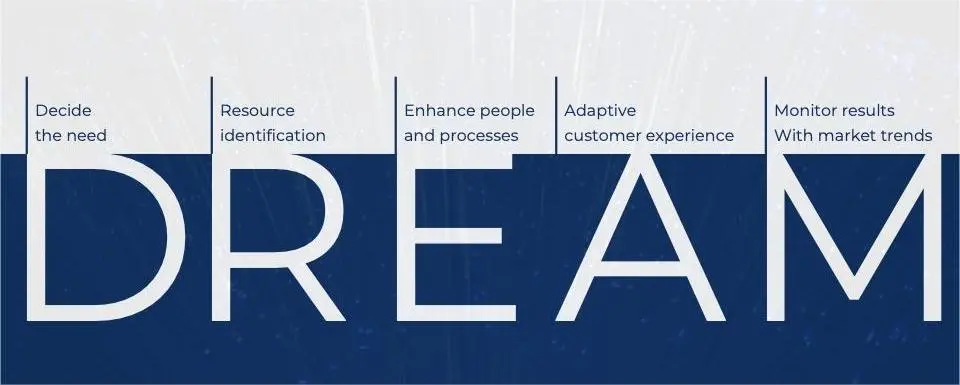DREAM Implementation of Technology Landscape for Digital Transformation in Education Vertical
“The Significance of Digital Transformation in Education”
Digital transformation in the educational sector is about integrating digital technologies and innovative practices to improve teaching, learning, and administrative processes within educational institutions. It encompasses utilizing tools like online learning platforms, digital resources, data analytics, and communication technologies to create more interactive, personalized, and efficient educational experiences.
This transformation is crucial because it allows educational institutions to adapt to the demands of the digital age and cater to the evolving needs of students, educators, and stakeholders. By embracing digital transformation, institutions can:
- Enhance Learning Experiences: Digital technologies enable interactive and personalized learning experiences, catering to diverse learning styles and preferences.
- Improve Accessibility: Online platforms and digital resources make education more accessible to learners regardless of geographical location or physical limitations.
- Increase Efficiency: Digital solutions streamline administrative tasks, reducing paperwork and manual processes, thus saving time and resources.
- Foster Collaboration: Digital tools facilitate collaboration and communication among students, teachers, and administrators, fostering a collaborative learning environment.
- Enable Data-Driven Decision-Making: Digital platforms collect valuable data on student performance and engagement, enabling educators to make data-informed decisions to optimize teaching methods and curriculum.
Overall, digital transformation empowers educational institutions to remain competitive, enhance educational outcomes, and better equip students for success in the digital era.
In recent digital transformation trends are expected to continue shaping the education sector:
- Projections indicate a 40% improvement in student engagement, increased utilization of both new and existing education services, and a higher rate of teaching innovation within the next three years.
- A reported 13% of colleges and universities have actively engaged in digital transformation initiatives.
- About 32% of higher education institutions are currently in the process of developing a digital transformation strategy.
- Additionally, 38% of Higher Education institutions are exploring various digital transformation opportunities to adapt to the demands of the digital age.
These trends underscore the growing recognition of the importance of digital transformation in education and its potential to revolutionize teaching, learning, and administrative processes.
Introducing DREAM Framework
In the journey towards digital transformation, it’s crucial to have a clear roadmap that guides us through each step. At ConneXRM, we believe in the power of the DREAM framework – a strategic approach to implementing technology in the education vertical.
Let’s delve into each element of the DREAM framework and illustrate its implementation through a practical example.

D – Decide the Need: The first step in our journey towards digital transformation is to carefully assess the needs of educational institutions. By comprehensively understanding their pain points and objectives, we can customize our solutions to tackle precise challenges and provide optimal value. The cornerstone of a triumphant digital transformation hinges on grasping the distinctive hurdles and goals of educational institutions. Through evaluation of the needs of students, faculty, and administrators, organizations can craft solutions that offer maximum efficacy. For instance, pinpointing issues like restricted access to course materials or ineffective communication channels serves as a springboard for strategic interventions.
R – Resource Identification: Once the need is identified, the next step is to allocate the right resources, whether it’s investing in technology infrastructure, recruiting skilled personnel, or securing financial backing, organizations must ensure they have the necessary resources to embark on their digital transformation journey confidently. At ConneXRM, we empower our clients by providing access to the resources needed to drive meaningful change.
E – Enhance People and Processes: Technology is only as effective as the people and processes behind it. We work closely with educators and administrators to streamline workflows, enhance collaboration, and foster a culture of innovation. Through workshops, training sessions, and ongoing support, we work closely with educators and administrators to enhance their capabilities and maximize the impact of technology on teaching and learning. By empowering stakeholders with the right tools and training, we enable them to leverage technology to its fullest potential.
A – Adaptive Customer Experience: In today’s digital era, personalized and adaptive learning experiences play a pivotal role in captivating students and fostering favorable outcomes. By harnessing AI-driven platforms and analytics, we provide educators with the tools to customize their teaching methods according to each student’s unique requirements, thereby enriching the learning journey significantly. Whether it entails suggesting supplementary resources based on performance metrics or providing timely feedback, these adaptive strategies not only bolster engagement but also yield positive learning results.
M – Monitor Results with Market Trends: Digital transformation is a journey, not a destination. To ensure long-term success, organizations must continuously monitor and evaluate their progress, adapting their strategies based on market trends and student feedback. Through data analytics and market insights, we help our clients track their student engagement, academic performance, and the effectiveness of digital initiatives. By staying agile and responsive to emerging trends, organizations can future-proof their digital initiatives and drive innovation in education.

Let’s illustrate the DREAM implementation with an example:
Consider a university aiming to enhance student engagement and academic performance. Through the DREAM framework, we collaborate with the university to:
1. Decide the need: Identify the challenges faced by students and faculty, such as limited access to course materials and ineffective communication channels.
2. Resource identification: Allocate resources for implementing a Learning Management System (LMS), providing training for faculty, and upgrading network infrastructure.
3. Enhance people and processes: Conduct workshops and training sessions to familiarize faculty with the new technology and optimize course delivery methods.
4. Adaptive customer experience: Implement AI-powered tools within the LMS to personalize learning experiences, such as recommending supplementary resources based on student performance.
5. Monitor results with market trends: Utilize analytics to track student engagement, course completion rates, and academic performance, adjusting strategies based on insights gleaned from market trends and student feedback.
In conclusion, the DREAM framework provides a comprehensive roadmap for organizations in the education vertical to navigate the complexities of digital transformation successfully. By embracing emerging technologies such as artificial intelligence, augmented reality, and blockchain, educational institutions can future-proof their digital initiatives and unlock new opportunities for innovation and growth. As we continue to embrace the digital revolution, staying agile and adaptive is paramount, ensuring that students receive cutting-edge learning experiences that prepare them for success in an increasingly digital world.



Leave a Reply
Want to join the discussion?Feel free to contribute!